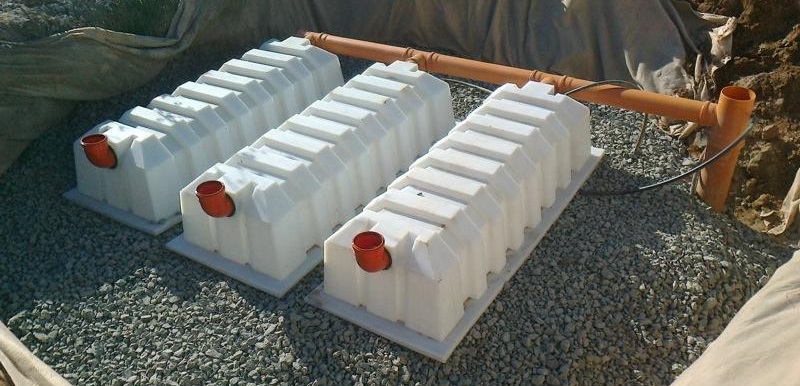Is it possible to drain water from a washing machine and dishwasher into a septic tank?
 A septic tank is a common thing for owners of private houses who choose an environmentally friendly treatment facility for their family, and thus create an autonomous sewage system. In this case, the water flows into a sump, where it will be purified with bioenzymatic agents and beneficial microorganisms. In this situation, an important question is the liquid used by the equipment - is it possible to drain water from a washing machine and dishwasher into a septic tank? Will waste water containing household chemicals spoil cleaning agents and beneficial bacteria?
A septic tank is a common thing for owners of private houses who choose an environmentally friendly treatment facility for their family, and thus create an autonomous sewage system. In this case, the water flows into a sump, where it will be purified with bioenzymatic agents and beneficial microorganisms. In this situation, an important question is the liquid used by the equipment - is it possible to drain water from a washing machine and dishwasher into a septic tank? Will waste water containing household chemicals spoil cleaning agents and beneficial bacteria?
Are washing and dishwashing appliances compatible with a septic tank?
If you choose the right septic tank for a private home, you can provide comfortable conditions that are in no way inferior to the living conditions in an apartment building maintained by a management company. But for such comfort, it is necessary to carefully follow all the rules for operating the sump. First of all, you need to study which liquid is permissible to pour into the septic tank, and which is prohibited from being used.
Residues of harmful detergents in water from washing machines and dishwashers can kill beneficial microorganisms that multiply in the septic tank.
However, not all chemicals for clothing and dishes can harm the septic tank and bacteria. There are chemical compositions without the use of chlorine, phosphates and petrochemical elements - such detergents are completely harmless to the cleaner. With such chemistry, waste moisture from “household aids” will not harm the septic tank in any way.
At the moment, special household chemicals for washing dishes, laundry and plumbing, which do not interfere with the operation of the autonomous sewage system, are widespread on store shelves. Such detergents were specially developed for owners of a cleaning device so that they do not have to worry about the composition of the water entering the septic tank. We would like to pay special attention to substances that should be avoided in detergents if you want to reuse waste water using a septic tank:
- chlorine;
- any household chemicals containing surfactants greater than 5%;
- phosphates;
- sulfates;
- petroleum products such as gasoline, oil, kerosene, solvents and others;
- alcohol;
- alkali;
- medications containing formaldehyde and oxidizing agents, which can cause an unpleasant odor in the septic tank;
- finally, any substances with dye or flavor.
The list of substances prohibited for septic tanks is long, but there are even more safe chemicals created using natural ingredients. Natural extracts, sodium carbonate, various vegetable and animal oils, biodegradable substances, and even ordinary soap do not harm the septic tank and beneficial bacteria, so finding safe chemistry is not so difficult.
The main rule that must be followed when caring for an autonomous sewer system is that the fewer harmful components that get there, the better and longer the treatment facility will serve you. Because of this, it is worth paying close attention to all the recommendations outlined above, and always carefully study the composition of the purchased chemicals so that they do not contain any harmful substances. This will not only increase the efficiency of the septic tank, but also increase its lifespan.
Where to dump “hazardous waste”?
Different things happen in life, so if you do not want to change your usual household chemicals, or there is no way to do this, then you need to figure out how to properly dispose of waste water containing harmful chemicals. When using non-ecological detergents, pour the used water not into the purifier, but into one of the suggested options:
- ground filtration areas;
- filter cassette;
- sealed container for water.
Sometimes on the market you can find special septic tanks that are not afraid of even the most harmful household chemicals, but such devices will not be cheap.
In a private home, you can easily organize any of the five listed methods for recycling water from a washing machine and dishwasher. The easiest and cheapest way is to organize an autonomous waste water collector. It will be more expensive, but more effective, to purchase a filter cassette for water purification.
The solution for handling waste water will be even more elegant if a large septic tank is installed on the site - in this case, you can not be afraid to drain liquid from household appliances into the purifier. 40-50 liters of water with detergent will not seriously affect the liquid with bacteria in a filled tank with a capacity of several thousand liters.
Therefore, if you use your washing machine or dishwasher less than ten times a month, then this amount of water with chemicals will not be able to kill beneficial bacteria or spoil the water. However, even in this case, it is better to switch to safe detergents made from natural ingredients, without the use of harmful chemicals. This way you will improve the quality of water in the sump and take care of the environment.
Interesting:
Reader comments
- Share your opinion - leave a comment





















Add a comment